
Columnea is a genus of ca. 200 species of epiphytic herbs and shrubs in the flowering plant family Gesneriaceae, native to tropical America and the Caribbean. The tubular or oddly shaped flowers are usually large and brightly colored – usually red, yellow, or orange – sometimes resembling a fish in shape. A common name is flying goldfish plants due to the unusual flower shape.
Hans Joachim Wiehler (1930–2003) was a German botanist who specialized in the plant family Gesneriaceae. In 1954 he received a Bachelor of Arts degree from Goshen College in Goshen, Indiana and a Bachelor of Divinity degree from Goshen Biblical Seminary in 1956. He married in 1958 and remained in the United States for the rest of his life. He obtained a master's degree in botany from Cornell University and in 1979 a PhD in Botany from the University of Miami. Wiehler was on the staff of the Marie Selby Botanical Gardens from 1973 until 1982, when he left Selby to found the Gesneriad Research Foundation in Sarasota, Florida.
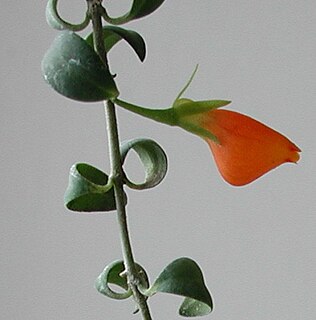
Nematanthus is a genus of flowering plants in the family Gesneriaceae. All of its species are endemic to Brazil. Compared to other gesneriads, Nematanthus has leaves that are small, succulent, and hard-surfaced. The plant has a trailing, branching, and spreading habit; it is generally an epiphyte in nature and a hanging-basket plant in cultivation.

Columnea glabra is a species of plant that may be found growing in montane cloud forest habitats in Central and South America. It commonly grows as an epiphyte.

Columnea flexiflora is a threatened species of plant from Ecuador.
Goldfish are small freshwater fish that are commonly kept in aquariums and ponds.

The Cuban moist forests is a tropical moist broadleaf forest ecoregion that occupies 21,400 km2 on Cuba and Isla de la Juventud. The ecoregion receives more than 2,000 mm (79 in) of rainfall annually, and does not have a dry season. Soils are usually derived from quartz, limestone, or serpentinites. Cuban moist forests can be differentiated into lowland forests, sub-montane forests, and montane forests.

Columnidin is an orange red pigment, belonging to the 3-deoxyanthocyanidins found in red-flowered western-hemisphere gesneriad species such as episcias, columneas, sarmientas, and sinningias.

Apiforol is a chemical compound belonging to the flavan-4ol class of flavonoids.
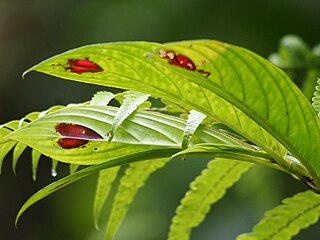
Columnea consanguinea is a species of flowering plants in the genus Columnea. They are endemic to Colombia, Costa Rica, Ecuador, Nicaragua, and Panama. They are distinctive for possessing red translucent heart-shaped markings on their leaves that serve to attract their main pollinators - the hummingbird Heliodoxa jacula - to their more inconspicuous flowers.
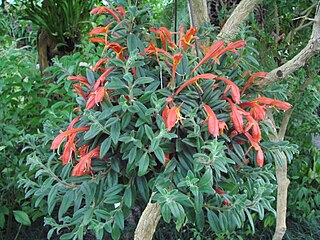
Columnea hirta is a species of flowering plants in the genus Columnea. They are endemic to Costa Rica and Panama but are widely cultivated as an ornamental.

Columnea gloriosa is commonly known as the goldfish plant, because of the fish shaped flowers it produces. It falls into the genus Columnea. Also known as a cousin to African violets. This plant is in the family Gesneriaceae. Some authorities have it as a synonym of Columnea microcalyx. Origins are from Central and South America and the Caribbean.

Columnea crassifolia is a species of Gesneriaceae that is native to Honduras and Mexico.

Columnea linearis is a species of Gesneriaceae that is native to Costa Rica, Nicaragua, and Belize.
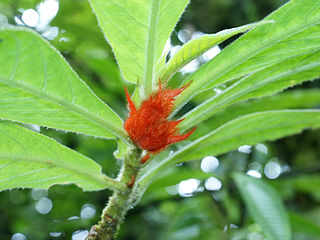
Columnea purpurata is a species of Gesneriaceae that is native to Costa Rica, Colombia, and Belize.

Columnea querceti is a species of Gesneriaceae that is native to Costa Rica.

Columnea rubricaulis is a species of Gesneriaceae that is native to Honduras and Nicaragua.
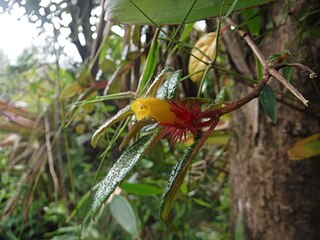
Columnea domingensis is a species of plant in the family Gesneriaceae. According to Liogier it can be found in the Dominican Republic and in Haiti.

The Gesnerioideae are a subfamily of plants in the family Gesneriaceae: based on the type genus Gesneria. Although genera typically originate in the New World, some species have become widely distributed as ornamental plants.

Columnea microcalyx, called the goldfish plant or orange columnea, is a species of flowering plant in the genus Columnea, native to southeast Mexico, Central America, Columbia and Venezuela. Its cultivar 'Superba' has gained the Royal Horticultural Society's Award of Garden Merit.

















